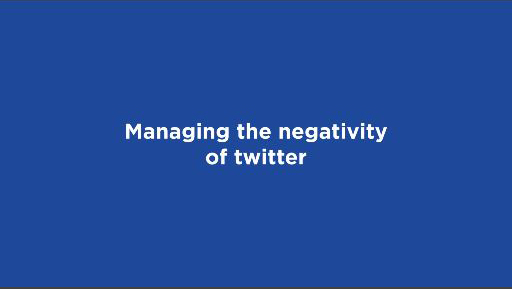2.3 Safety on Twitter
Often people who are discovering Twitter for the first time are excited by the many like-minded people on it. It is possible to directly hear from people in your field, or to connect with students interested in niche areas of study. However, Twitter is also a place of divided opinions. There is a lot of misinformation and bad behaviour on Twitter. Some of this is from individuals with malicious intentions, other times it is from bots who are designed to create controversy on the platform.
Here Olivia Kelly talks about how the students she interviewed managed the negative aspects of Twitter.

Transcript: Video 13 Managing the negativity of Twitter
There is not space here for an extensive debate on this aspect of Twitter, some people even think that it will be the end of the app as people leave it because of the negativity. Olivia described how students manage this and it is very important when engaging in Twitter to closely monitor the impact that Twitter engagement has on your mood and motivation.
Activity 6 Placing boundaries on Twitter
Librarian Ned Potter has written about his experiences of using Twitter. Read the section entitled ‘What advice would you give someone who’s just joining Twitter now?’. Make a note of the five points that Ned is focused on in his Twitter use.
Discussion
One of the most important things you can learn about Twitter is that in order to manage your interaction you should have your own ground rules for who and when you engage with the platform. You will learn more about how you can place boundaries on Twitter in this activity.
Both Facebook and Twitter are social media apps that have the potential to be completely public. As Twitter can be a challenging space in which there is lots of potential for conflict it is sometimes necessary to establish boundaries you can stick to when you’re using the app. Answer the following questions about Twitter to learn more about the choices you can make if you choose to use Twitter.
a.
True
b.
False
The correct answer is a.
Answer
True, it is possible to block people from seeing your tweets using the block function in Twitter.
a.
True
b.
False
The correct answer is a.
Answer
True, the same functionality that allows you to block people from seeing your tweets also prevents them from seeing yours.
a.
True
b.
False
The correct answer is a.
Answer
True. The default privacy setting for Twitter at the time of writing was that all content is public unless the individual user changes the settings to private.
a.
True
b.
False
The correct answer is a.
Answer
True: see Activity 5 for more details on how to do this.
a.
True
b.
False
The correct answer is b.
Answer
False, see Activity 5 for more details on how to do this.
a.
True
b.
False
The correct answer is b.
Answer
False, while the delete function allows you to remove a tweet, it is always possible that someone has taken a screenshot of the content which they can they share.
a.
True
b.
False
The correct answer is b.
Answer
False, while the delete function allows you to remove a tweet, it is always possible that someone has taken a screenshot of the content which they can they share.
a.
True
b.
False
The correct answer is a.
Answer
True, many organisations now use Twitter to promote their brand or organisation, being able to use Twitter is thus seen as a valuable skill.
In the final session you will consider further how you can protect aspects of your digital identity. Not all forms of social media are public, some are designed to be more private, and one that is starting to gain attention in Higher Education is WhatsApp. You will learn more about this in the next section.
